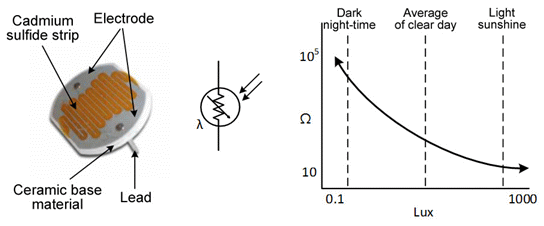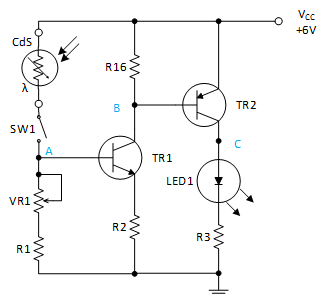PART10Characteristic Circuit of Electric Element
Experiment Purpose
- 1.Understands characteristic of CdS.
- 2.Understands lighting control.
- 3.Understands characteristic of thermistor.
- 4.Understands temperature control.
Experiment 1 :Lighting Control Switch Circuit
Theory
The illumination sensor is the most basic sensor of optical sensor, which changes the brightness of the light to the electric characteristic. CdS(Cadmium sulfide) is the most commonly used illumination sensor, a.k.a. photo conductive cell or light dependent resistor(LDR), and in the dark place, the resistance increases as the insulator and when the visible light is touched, the resistance decreases as the conductor. This sensor is highly sensitive, small, cheep and sensitive to the visible light but the response time is slow so is not suitable for the sensor that needs immediate response. If the amount of light is big, the speed gets faster and likewise, the response time changes according to the amount of light but this is rather incomplete advantage. Fig.10-2 shows the structure, symbol and characteristic of CdS.
The characteristics of CdS are as below.
- Spectrum response: spectrum range of 550~650nm
- Illumination: the relationship between the illumination and the resistance is linear within the illumination level of 0.1~1,000Lux.
- Response speed: the decay time is generally from 10ms to several seconds. The rise time is longer than the decay time.
- Temperature range: the range of operation temperature is–20~70℃.
To measure the exact number of lux, photo diode element should be used. It is a type of photo sensor just like CdS and it can detect various ranges of light sources from visible light to infrared ray but is relatively expensive and its peripheral circuit becomes complex. However, the resistance value to the light comes out linearly so it is easy to be digitized and the program source becomes simple.
In case of GL5516 as an example, the resistance is 200KΩ when it is dark and 5~10kΩ at 10 Lux so to measure 10 Lux, the most errorless input can be earned by using the resistance of 7.5KΩ.
The application of CdS detector which is a photo conductive element can be categorized as two areas. One is the area that is determined by the action of detector such as continuous variable resistor and the other determined by high and low resistances for switching operation.
The circuit in fig.10-3 is a circuit that applies the switch characteristic of CdS detector.
If the light is shone on CdS, it becomes a serial circuit with VR1 and R1. The voltage drop of VR1 and R1 supplies a bias to the base of TR1, and the current flows between the collector-emitter of TR1 so it supplies the voltage drop to the collector resistance R16. This voltage drop becomes the base bias of TR2 and TR2 is conducted and LED1 is turned on. If the light shone on CdS decreases, the resistance of CdS (RCDS) increases. This reduces the base voltage of TR1 (voltage of A point =  ) is cut off. So TR2 is also cut off and LED1 is turned off.
) is cut off. So TR2 is also cut off and LED1 is turned off.
Experiment Process
1. Use CdS element of Block a on M10 board.
2. Measure and record the current resistance value of CdS using the multimeter.
3. Measure and record the resistance value of CdS by darkening CdS using the hands.
4. Based on the results above, describe how the resistance value of CdS changes according to the intensity of light.
5. Apply light to CdS using the nearby lamp and measure and record the resistance value of CdS.
6. Describe how the resistance value under normal state and that under the light are different.
tab1Experiment 10-1.1 Experiment of CdS Characteristic
1.Connection(Block a of M10)
1.Measuring Instrument Connection
Connect between High terminal of Multimeter on front panel and V+ terminal of Block a on M10 board with red line, and between Low terminal and the lower terminal of CdS with black line.
2.Wiring Diagram
3.Measurement
- 1Choose dmm at the left menu of Touch LCD panel and click .
Record the measured resistance value of CdS in the relevant column of table 10-1.
Measure and record the resistance value of CdS by darkening CdS using the hands.
Apply light to CdS using the nearby lamp and measure and record the resistance value of CdS.




